Researchers Cori Lausen and Maleen Mund step out of the warm spring sun and into a dimly lit workshop. The only light streams in through the doorway behind them and a few dusty windows. It’s been a cool start to the season in the Lower Mainland, but some bats have already emerged from their winter hibernation. A couple dozen are roosting in cozy clusters in the rafters of this old, wood building near Hayward Lake, about 60 kilometres east of Vancouver.
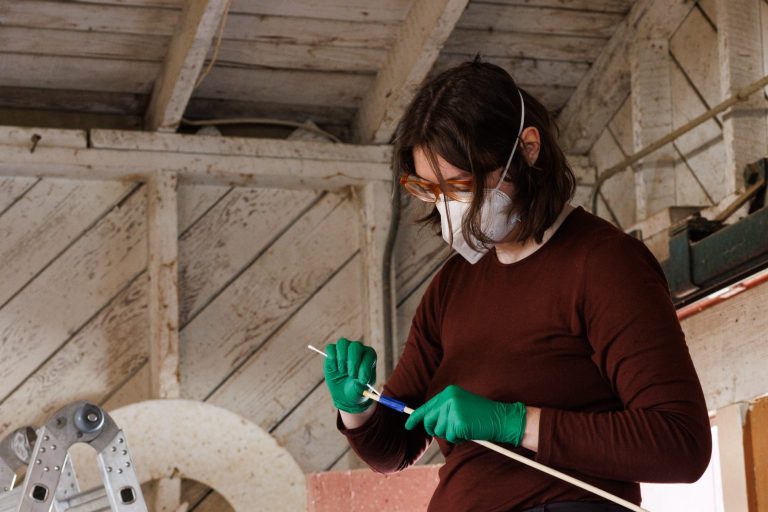
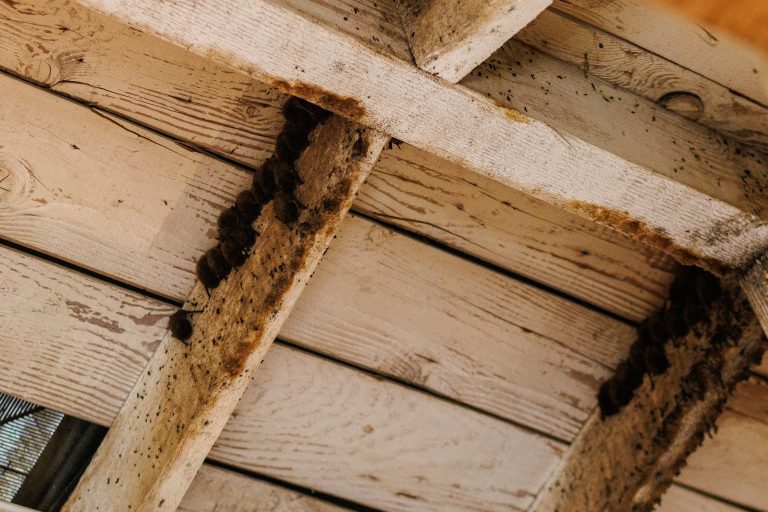
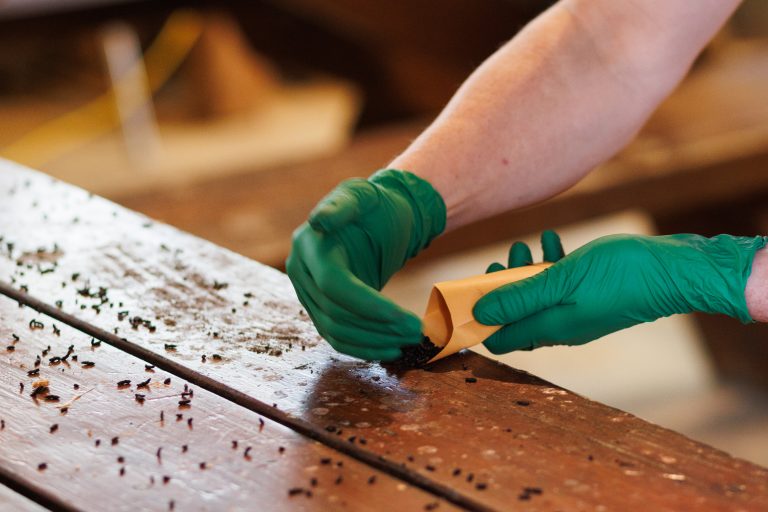
Over the past two decades, white-nose syndrome has killed millions of bats across North America. In the continent’s east, where the fungal disease was first detected, its toll is plain in the piles of small bodies littering cave floors, the remains of thousands of bats that succumbed to infection during hibernation. As the disease spread west, Lausen, the director of bat conservation at Wildlife Conservation Society Canada, raced to find a solution.
Now, on the verge of confirming what could be a game-changing probiotic treatment for white-nose syndrome, Lausen is facing a new hurdle: U.S. President Donald Trump and his mission to slash government spending.
The new so-called Department of Government Efficiency, led by billionaire Elon Musk, started implementing massive funding cuts, hiring freezes and firings soon after Trump’s inauguration in January. The consequences have rippled well beyond U.S. borders. Lausen’s white-nose research was one of the Canadian projects affected. She was notified by the U.S. National Fish and Wildlife Foundation in January that her funding had been paused.
The team won a reprieve, but the grant expired in February. And although the organization has applied to the U.S. Fish and Wildlife Service for a new round of funding to support its crucial next phase of study, Lausen doesn’t have much hope of success.
The funding debacle leaves Lausen with a mix of emotions — excitement that early results are promising and panic that the Trump administration’s funding cuts could unravel the whole project.
“It’s like seeing the finish line, but not quite being able to cross it,” she says.
An ‘ugly death’: white-nose syndrome eats away at bats’ skin as they hibernate
Bats are often misunderstood and maligned. They’re seen as scary pests, linked with vampires or the spread of disease. But these flying mammals are a crucial part of ecosystems — nighttime predators that help keep insect populations in check. They’re important in their own right, but also to people. When bat populations decline, farmers use more pesticides, costing them money and putting human health at risk.
White-nose syndrome has devastated bat colonies in North America. It takes hold during hibernation, the time of year when bats’ defences are weak. Their bodies have cooled and their immune systems have essentially switched off to conserve energy, giving Pseudogymnoascus destructans ample runway to develop into a disease that can be fatal. As the fungus grows on their noses and wings, it eats away at their skin, rousing bats from their hibernation several times through the winter. As they groom the fungus from their wings, and their bodies warm up, their immune system turns back on, joining the battle against the disease. But the fight comes at a cost. It uses vital fat stores, putting bats at risk of starvation before their first feed of spring. “It’s a pretty ugly death,” Lausen says.
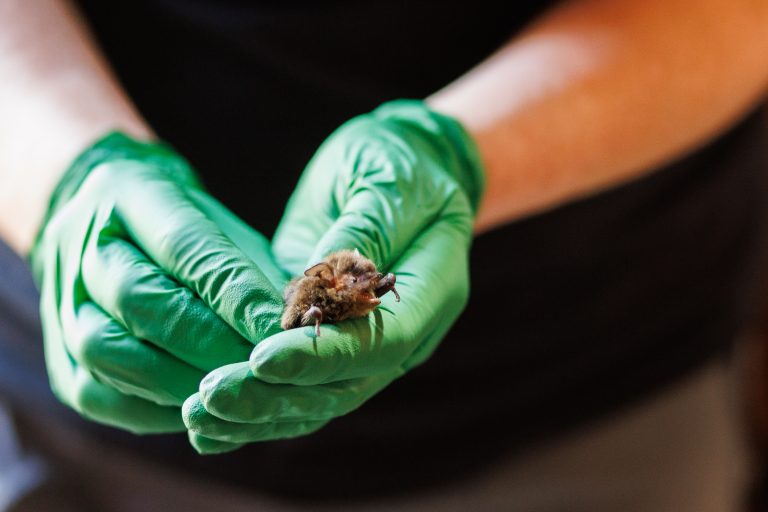
Canada listed three bat species as endangered in 2014 after the disease caused populations to plummet in eastern provinces. Since then, white-nose syndrome has spread further west, leapfrogging into Washington State in 2016. The leading hypothesis, Lausen says, is that a stowaway bat hitched a ride on a transport truck travelling west from the state of Kentucky to the Port of Seattle.
Lausen knew it was only a matter of time before the fungus showed up in B.C. She also knew treatments being tested in the east wouldn’t work in the west. In the east, thousands of bats spend the winter in caves. But in the west, bats seem to hibernate in smaller groups dispersed across the landscape, often in deep crevices or hollows underground.
It means the fungicides and other chemicals scientists spray on hibernating bats in the east aren’t really an option here. But the large maternity roosts, where hundreds or thousands of bats congregate over the spring and summer to birth and raise their babies, present an opportunity.
Lausen worked with scientists at Thomson Rivers and McMaster universities to develop the probiotic, a cocktail of beneficial bacteria — originally sourced from bats — that they hoped would give bats the boost they needed to fight off the fungus before it developed into the disease. Lab trials were promising, but Lausen needed to test it in the real world.
Each spring and summer since 2019, her team has applied the probiotic to bat boxes at Hayward Lake, a site near Squamish, B.C., and another site closer to Vancouver. The fungus hasn’t yet been detected in the area. But the idea is the bats will pick up enough of the probiotic as they move in and out of the boxes to keep the disease at bay through hibernation if they do become infected.
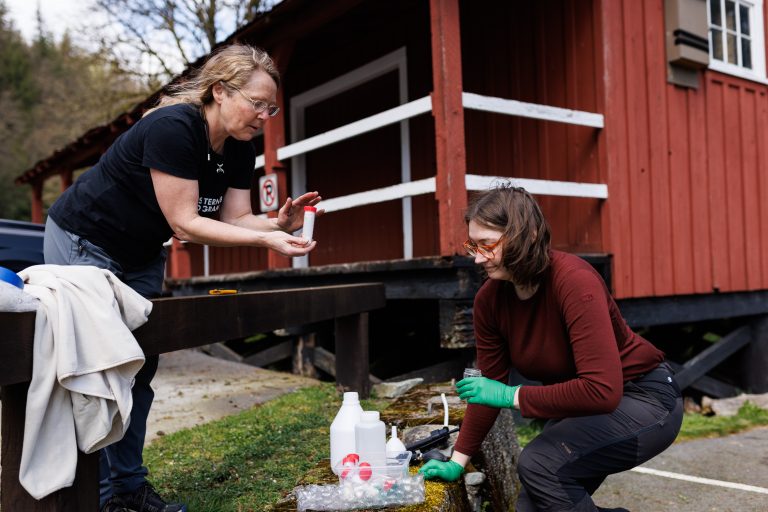
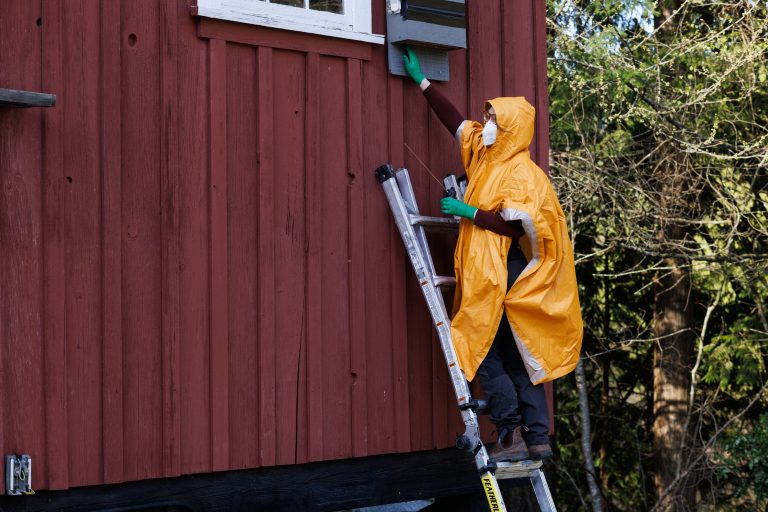
Outside the workshop, Mund dons a yellow poncho and a fresh pair of green lab gloves. She heads up the ladder to one of the three bat boxes fixed to the side of a red building. For the past few years, the team has been using a modified bike pump to apply a mix of clay and probiotics to the bat boxes. It works, but it’s messy: hence the poncho.
Today Mund is trying out a new applicator on a test box. First, she soaks each chamber of the box with water, so the mixture has something to stick to, then she puffs in the powder.
Even with the study at risk from Trump’s funding cuts, the team is thinking about the best options for scaling up the treatment. The hope is that one day they’ll be able to ship the probiotic mix to community volunteers who can apply it at local roosting sites around the continent to protect as many bats as possible.
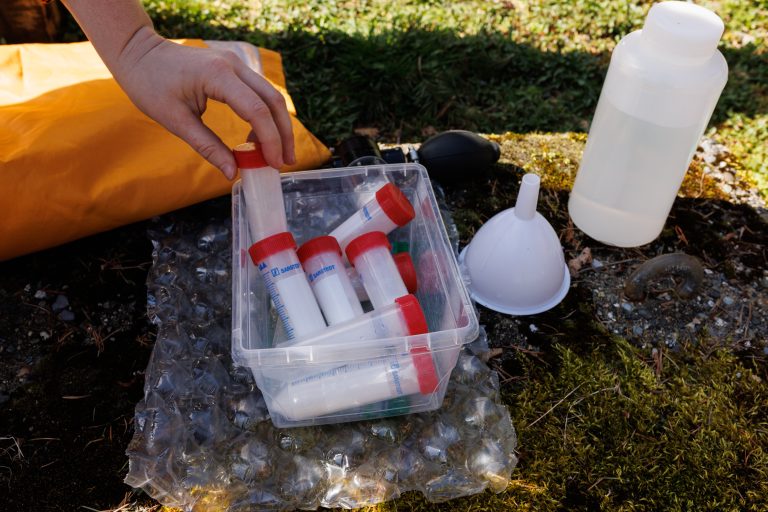
Lausen says the probiotic mix has shown up at control sites where the researchers never applied it, evidence the bats themselves are spreading it around. That could make it slightly more difficult to parse the results of their study, but she says it’s ultimately good news.
If the probiotic proves effective at fighting off white-nose syndrome, it means the bats themselves can help redistribute the wealth of good bacteria — it’s why Lausen calls this a “Robin Hood” treatment. The beneficial bacteria could become part of the bats’ microbiome, eventually negating the need for frequent treatments. But without more definitive evidence the probiotic works, she worries they won’t get the funding they’d need to go full sail.
Washington study sites key to understanding probiotic’s promise in white-nose syndrome fight: biologist
Lausen is confident, though, that the compelling evidence the researchers need can be found across the border in Washington. In the past several years, there have been two mass mortality events attributed to white-nose syndrome documented in the state. About 100 bats succumbed to the disease — all of them yuma myotis, a species found only in the west. For Abby Tobin, the Washington state bat biologist working with Lausen, the deaths underscore the risks for bats in the region, raising questions about how many are already dying unseen.
For the past two years, Lausen’s been working with Tobin to test the probiotic at three roost sites in the state. Early results show bats with higher levels of the probiotic had lower levels of Pseudogymnoascus destructans and, in some cases, no fungus at all. “Nothing has ever looked so positive until this winter,” Lausen says.
Tobin agrees. “It’s helping shift the microbiome on these wings for the better, so that’s really promising and hopeful,” she says in an interview.
But can probiotics definitively treat white-nose syndrome? The scientists need more time to be sure.
“This is a critical point in the study,” Tobin explains. While the preliminary results are encouraging, the disease is still in the early stages at all three sites. Studying the probiotic’s effect over the next two years as the disease develops could offer “pretty clear results,” she says. They just need the money to do it.
One small saving grace is that white-nose syndrome seems to be spreading slightly slower in the west than it did in the east. Lausen says it’s not entirely clear why: it could be that bats are dying during hibernation undetected or, because the winters are shorter, the fungus has less time to take hold before bats emerge in the spring better able to fight it off.
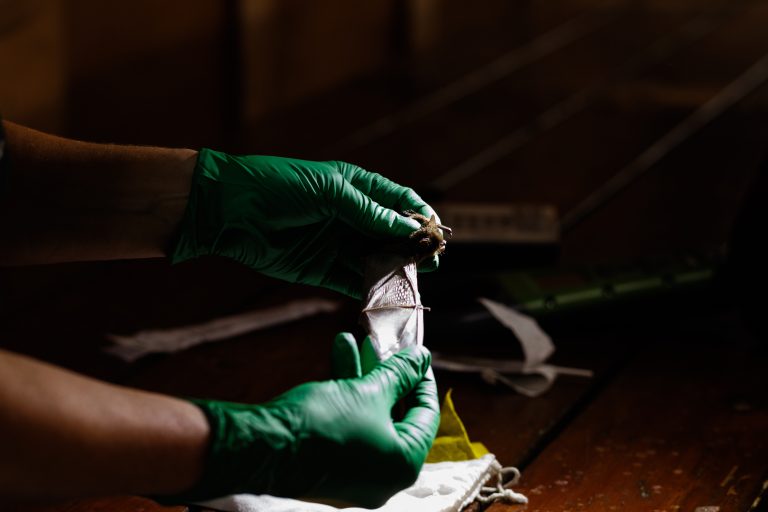

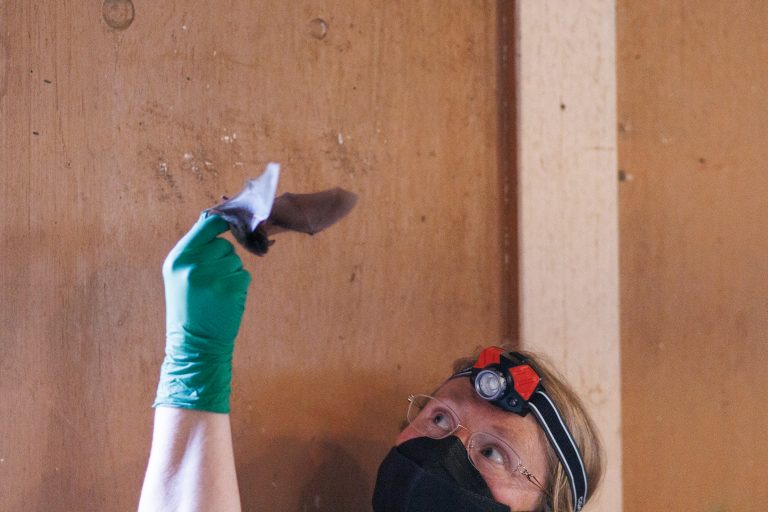
At the Hayward Lake workshop, Lausen holds up a small bag, the outline of a bat just barely visible through the backlit cotton. As Mund raises the “bat detector,” a device that picks up ultrasonic frequencies, squiggly lines dance across the screen. The bat’s echolocation calls are too high a frequency for human ears to hear, but the shape of the sound waves tell Lausen this is a yuma myotis bat, the same species found in the Washington state mass mortality events.
Every spring, before the next treatment, the researchers catch bats and swab their skin. They want to know how the probiotic lasted through the winter — and if the fungus has made any inroads to B.C.
Lausen pulls the tiny fur ball from the bag and gently extends one wing. As Mund takes a swab, the light from her headlamp illuminates the veins that weave through the delicate, translucent membrane. As Lausen scrambles to secure new funding for the Washington study, her team will swab many more wings as more bats emerge from hibernation. But this is all for now. Lausen releases the bat to return to its slumber, its speed and agility on full display as it swoops down, then up and away.
This article by Ainslie Cruickshank was first published by The Narwhal on 10 April 2025. Lead Image: Ainslie Cruickshank / The Narwhal.
What you can do
Wildlife continues to face threats, which include hunting, poaching, illegal trade in animal products, habitat loss as well as a rapidly changing climate.
Become a Wildlife Champion by supporting our conservation partners with a monthly donation as little as $1.
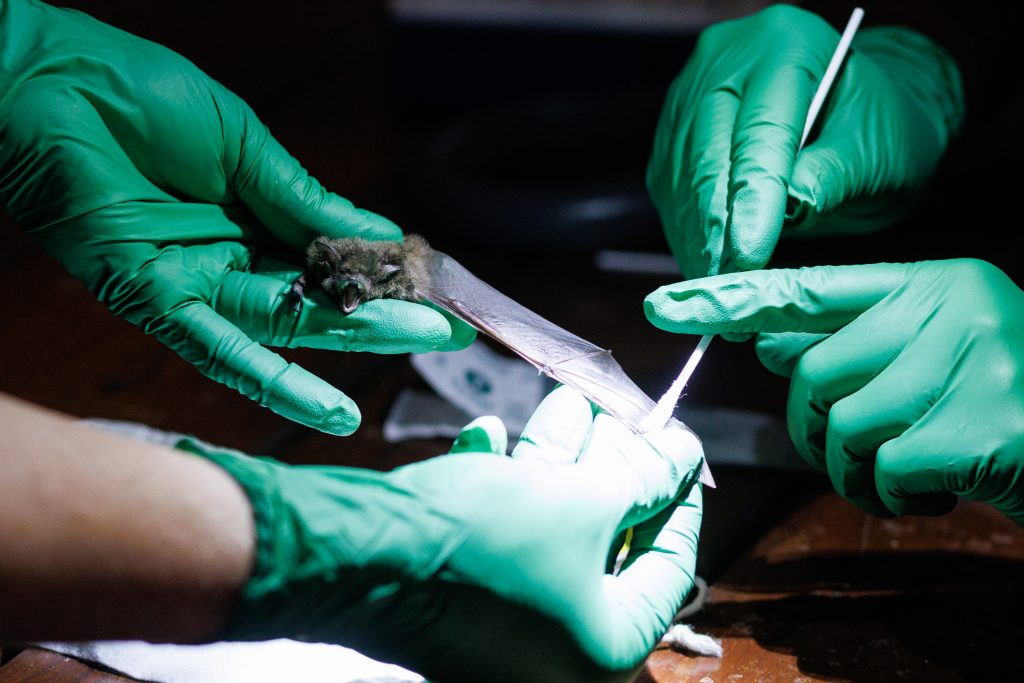
 Donate
Donate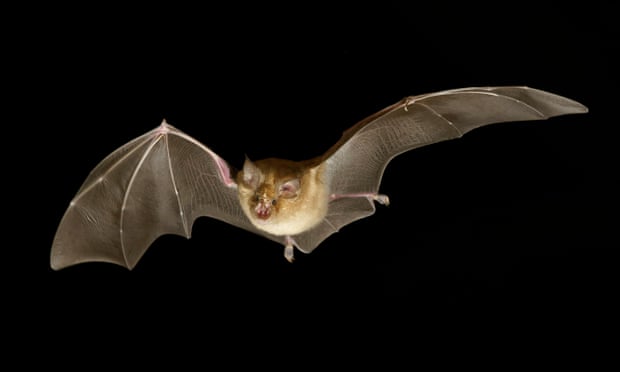





Leave a Reply